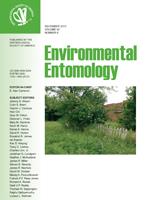The recently introduced plataspid Megacopta cribraria (F.) can infest fields of soybean (Glycine max (L.) Merrill) in the southeastern United States. Grid sampling in four soybean fields was conducted in 2011 and 2012 to study the spatial distribution of M. cribraria adults, nymphs, and egg masses. Peak oviposition typically occurred in early August, while peak levels of adults occurred in mid-late September. The overall sex ratio was slightly biased at 53.1 ± 0.2% (SEM) male. Sweep samples of nymphs were biased toward late instars. All three life stages exhibited a generally aggregated spatial distribution based on Taylor's power law, Iwao's patchiness regression, and spatial analysis by distance indices (SADIE). Interpolation maps of local SADIE aggregation indices showed clusters of adults and nymphs located at field edges, and mean densities of adults were higher in samples taken from field edges than in those taken from field interiors. Adults and nymphs were often spatially associated based on SADIE, indicating spatial stability across life stages.
How to translate text using browser tools
1 December 2013
Within-Field Spatial Distribution of Megacopta cribraria (Hemiptera: Plataspidae) in Soybean (Fabales: Fabaceae)
Nicholas J. Seiter,
Francis P. F. Reay-Jones,
Jeremy K. Greene
ACCESS THE FULL ARTICLE
It is not available for individual sale.
This article is only available to subscribers.
It is not available for individual sale.
It is not available for individual sale.

Environmental Entomology
Vol. 42 • No. 6
December 2013
Vol. 42 • No. 6
December 2013
Megacopta cribraria
spatial analysis by distance indices
spatial association




